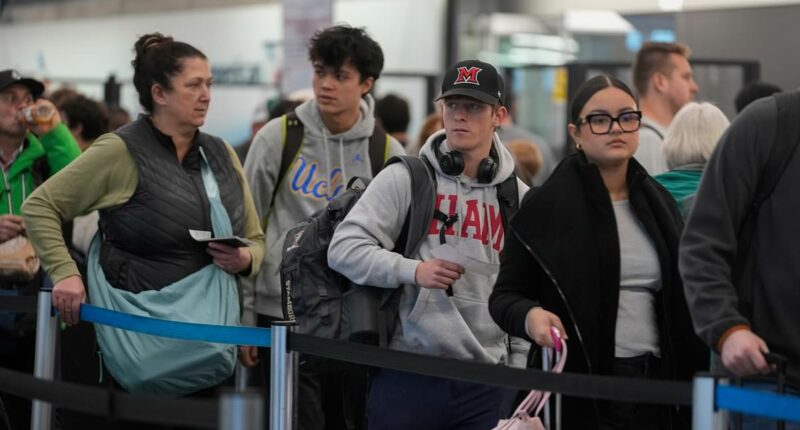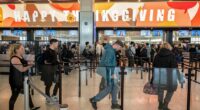Share this @internewscast.com
Millions of Thanksgiving travelers are facing widespread disruptions as a powerful winter storm sweeps across the United States, affecting both air travel and road conditions.
On Wednesday morning, the Federal Aviation Administration (FAA) implemented a ground delay at Chicago O’Hare International Airport due to accumulating snow and ice on the runways.
This delay is expected to continue until 10 p.m. ET, with departing flights already experiencing average wait times exceeding one hour.
According to Flight Aware, over 2,300 flights entering and leaving the U.S. have been delayed today, with more than 350 affected at Chicago O’Hare alone.
In Houston, departures at George Bush Intercontinental Airport encountered 30-minute delays due to strong winds, and the FAA anticipates these wait times will increase as the day progresses.
Even in areas where weather conditions have improved, the holiday travel surge is causing significant delays at airports, as they struggle to manage the high volume of flights attempting to take off and land simultaneously.
Orlando International Airport in Florida has announced flight delays of more than 30 minutes to ease the volume on busy runways.
Meanwhile, heavy snow is predicted to bring blizzard-like conditions to several states, including the Dakotas, Wisconsin, Minnesota, and Michigan, where more than a foot of snow may fall by Thursday.

Delays at Chicago O’Hare International Airport (Pictured) have left nearly 200 flights waiting to take off on Wednesday

Forecasts for the Thanksgiving travel period show plunging temperatures through half the US, caused by the polar vortex bringing freezing air from Canada
AccuWeather has warned that airport in Chicago, Minneapolis, and Detroit will likely continue to be affected by ‘several inches of snow’ through Sunday.
AccuWeather senior meteorologist Dan Pydynowski said: ‘Even a few inches of snow at major airports such as Chicago O’Hare or Minneapolis–St. Paul can lead to delays and cancellations for travelers heading home.’
‘De-icing operations and snow removal on runways can create a domino effect, with disruptions at key hubs leading to delays at airports across the country.’
Several airports throughout the US experienced temporary delays Wednesday morning, as busy travel hubs, including Phoenix Sky Harbor International, briefly grounded flights due to the increased volume of planes trying to take off at once.
Extremely long lines at airport check-ins have been seen at Boston Logan International Airport and Hartsfield-Jackson Atlanta International Airport, the nation’s busiest airport.
The FAA has also announced plans for possible ground stops at New Jersey ‘s Newark Liberty International Airport and Washington DC’s Ronald Reagan Washington National Airport Wednesday afternoon.
The list of potential disruptions or delays at these airports is based on FAA forecasts for problematic traffic, weather, staffing, or other operational factors.
The warnings are proactive alerts to help airlines, pilots, and travelers prepare for delays, but they are not guaranteed to occur.

Hartsfield-Jackson Atlanta International Airport (Pictured), the nation’s busiest travel hub, has seen extremely long lines as Americans take off for the Thanksgiving weekend

Crowds of flyers at Hartsfield-Jackson Atlanta International Airport Wednesday. An estimated 81.8million people planned to travel more than 50 miles this week to celebrate Thanksgiving
The remnants of the coast-to-coast storm which barreled into the Northeast on Tuesday has now sent temperatures plunging by 15 to 20 degrees throughout half the nation.
States from Maine to North Carolina along the East Coast, and all the way across the Midwest to Nebraska and Kansas, should expect the frigid temperatures to hold into Thanksgiving.
In New York, wind gusts of up to 40mph could force the annual Macy’s Thanksgiving Day Parade to change its plans for the high-flying balloons.
AccuWeather lead long-range expert Paul Pastelok said: ‘The balloons should be able to fly, but they may be kept closer to the ground. If stronger winds forecast for the afternoon arrive a few hours early, plans to fly the larger balloons could be impacted.’
‘The wind tunnel effect between buildings could make [the winds] feel even stronger in some spots,’ Pastelok added.





